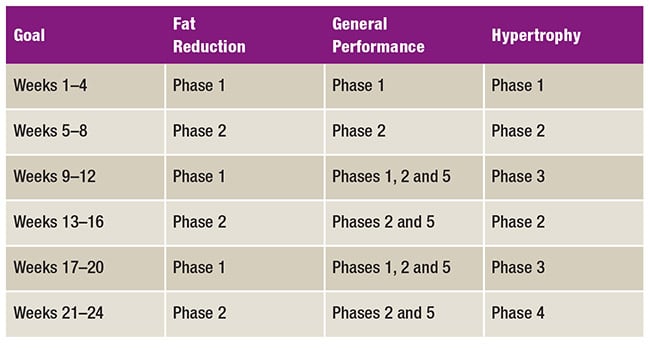By
COVID-19 forced gym closures, which in turn disrupted sessions for many personal training clients.
As a trainer, here are some specific ways the NASM Optimum Performance Training™ model can ease their minds as they gradually resume their routines.
THE NEED FOR SAFELY RETURNING TO TRAINING
I played Division I volleyball in college, and I still remember the dread I felt when it was time to return to the gym after winter break to begin spring training. Each year we’d have 6 weeks to go home and enjoy the holidays.
The problem was, many of us didn’t adhere to a consistent training routine during that time. Even if we did, we knew that the first day back would be intense: After a 2-hour practice on the volleyball court, we’d hit the weight room to lift for about an hour, then we’d proceed to the track for conditioning.
Needless to say, for the next week we’d all be so sore we couldn’t move without grimacing. Even though we wore that pain like a strange badge of honor, those memories of soreness and suffering bubbled up every time spring rolled around.
COMMON WORRIES FOR GETTING BACK INTO WORKING OUT AFTER A LONG BREAK
I imagine that many of our clients feel trepidation at potential soreness and injury at some level after sheltering in place for many weeks due to COVID-19. Here are some of the thoughts that might run through people’s minds:
- “Did I lose all of my progress?”
- “Will I have to start from scratch?”
- “Will I be sore for days after my first workout back at the gym?”
These worries are understandable: Many clients have experienced a significant lapse in exercise. Forced business closures disrupted gym workouts for most people by 8 weeks or more, with some facilities fluctuating between open and closed depending on changes in case numbers.
At best, our clients continued to train with us virtually, likely with limited or no equipment.
(Did anyone else have a client grab a gallon of water for “dumbbell” curls?) At worst, they paused training entirely. Others progressed in fits and starts as they tried to juggle home workouts with homework for quarantined kids or distractions from curious pets.
Now, more than ever, it’s our job as fitness professionals to ease our clients’ minds and get people back on track, working confidently toward their training goals once again.
The question is: How can we use the NASM Optimum Performance Training model to assess where clients are now—and begin to progress them safely and efficiently once more?
REVIEW THEIR PAR-Q FORMS

Communicating well with a client goes a long way during a time of uncertainty. Hopefully, you were able to maintain a line of communication with your clients whether they continued to train with you or not.
If you weren’t, it’s never too late to reach out and ask how they’re doing and how you can help them as gyms reopen. If you haven’t talked to some clients in a few weeks (or longer), keep in mind that they may not be in a good head space right now, so tread lightly.
When you do manage to connect, your first order of business is to find out what your clients have been up to while sheltering in place and, from there, reassess their goals and priorities.
Even though your clients aren’t new, it’s very possible that their primary objectives have shifted during the shutdown. That’s why it’s important to talk with clients prior to their return.
Living through a pandemic is a unique experience, so you may find it helpful to look at your clients’ PAR-Q forms to see if any answers could be affected by shelter-in-place orders, stress or illness due to the virus.
QUESTIONS TO ASK CLIENTS ABOUT THEIR WORKOUT ROUTINES
Here are some sample questions that you might ask about a client’s goals and workout routine:
- Before COVID-19, your goal was [state their goal(s) here]. Is this still what you would like to work toward? If not, what are your current goals?
- Tell me about your workout routine while you were sheltering in place. If you continued to work out, how many minutes/day and days/week were you active? What types of activities did you do? How intense were those activities on a scale of 1–10? (Urge clients to be honest and remind them that you are not judging their progress but, instead, planning for how to move forward safely!)
- During the shutdown, did you start any new workout routines, like walking, running or biking? Would you like to continue these activities and incorporate them into your new plan?
- What training schedule works best for you right now? Before businesses closed, we were training on X, Y and Z days. Would you like to return to this schedule or adjust it?
These questions are a great way to open the conversation with a client so you both know where that person is starting as the gym reopens. However, knowing what someone has been up to is only one piece of the puzzle.
REDO THEIR OHSA
When clients were sheltering in place, it’s likely their daily movement habits changed—and not always for the better. Many of my clients reported binge-watching shows, reducing their daily step count (because they were not leaving the house) and working for extended hours because, well, what else did they have going on?
After hearing these reports, I couldn’t help but anticipate some movement compensations (hello, shortened calves and hip flexors).
As your clients resume their sessions with you, taking a fresh look at their overhead squat assessment (OHSA) will provide valuable information about which muscles need to be lengthened and which ones need to be strengthened to help clients move better.
EASE IN WITH PHASE 1
For most returning clients, Phase 1: Stabilization Endurance will be the best place to start. Not only will you be able to address any movement compensations you find, but you will help your clients reestablish a solid foundation of fitness by focusing on stability and muscular endurance training.
“What if some clients have been training with me virtually throughout this pandemic? Do these clients have to start in Phase 1, too?” you ask. Great question! As all fitness professionals love to say when asked for advice on another trainer’s clients, it depends.
If a client had a decently stocked home gym that allowed you to continue to periodize workouts as planned and the client’s OHSA results show good movement patterns, then it may be appropriate to continue with the current plan. However, in most cases, even clients who trained virtually will benefit from starting with a shortened Phase 1 program of just 2 weeks (instead of 4–6 weeks).
RE-REASSESS THEIR OHSA (AND PROGRAM)
This is the time to look for improvement in previously noted movement compensations.
If clients are not showing progress in this area, you may need to allow more time in Phase 1. It would also be wise to reassess your programming to be sure you’re including warmup and resistance training exercises that will improve these compensations.
If clients are improving, you can progress them to the next phase that is appropriate for their goals and interests. (Check out the two examples in “Not Just a Phase: Different Plans for Different Goals,” page 50.)
A MODEL FOR THE AGES

Even though our day-to-day life has changed a great deal during this pandemic, how we use the OPT model with a client doesn’t change. We begin with assessment.
From there, we make a training plan that takes into account the client’s goals and OHSA results; choose the phases of the OPT model that match his or her goals and interests; train in each phase for 4 weeks; and then repeat the overhead squat assessment before progressing to the next phase.
If you follow this formula with your clients, they will be sure to succeed. Communicate your plan, reassuring them that you’re focused on helping them progress systematically and, most importantly, safely.
When they know that your goal isn’t to crush them on their first week back, you can help them transform any anxiety about returning to the gym into excitement about getting back to their training routines with you.
NOT JUST A PHASE: DIFFERENT PLANS FOR DIFFERENT GOALS

As many have said about the pandemic, “We’re all in the same storm, but we’re not all in the same boat.” Not everyone is as shipshape as they were to begin with. For example, clients who were formerly training for an event or making muscle gains may now be more motivated to work on losing their “lockdown pounds.” A select few may have used the time to shift their diet, so they’re ready now to focus on performance rather than weight loss.
Below are a few examples from Chapter 14 of NASM Essentials of Personal Fitness Trainings (6th ed., 2018, pp. 381–85) that illustrate how different goals influence workout programming, specifically with regard to phases—particularly 2 months after returning to the gym.

